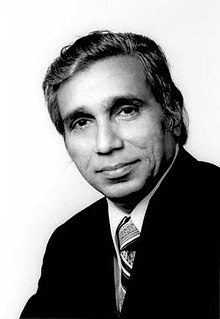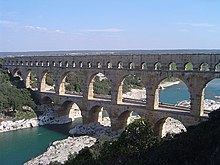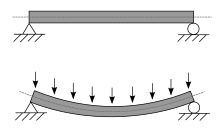Structural engineering



Structural engineers are trained to understand and calculate the stability, strength and rigidity of built structures for buildings[1] and nonbuilding structures, to develop designs and integrate their design with that of other designers, and to supervise construction of projects on site.[2] They can also be involved in the design of machinery, medical equipment, vehicles etc. where structural integrity affects functioning and safety.
Structural engineering theory is based upon applied physical laws and empirical knowledge of the structural performance of different materials and geometries. Structural engineering design utilizes a number of relatively simple structural elements to build complex structural systems. Structural engineers are responsible for making creative and efficient use of funds, structural elements and materials to achieve these goals.[2]
Structural Engineer (Professional)
Structural engineers are responsible for engineering design and analysis. Entry-level structural engineers may design the individual structural elements of a structure, for example the beams, columns, and floors of a building. More experienced engineers may be responsible for the structural design and integrity of an entire system, such as a building.
Structural engineers often specialize in particular fields, such as bridge engineering, building engineering, pipeline engineering, industrial structures, or special mechanical structures such as vehicles, ships or aircraft.
Structural engineering has existed since humans first started to construct their own structures. It became a more defined and formalised profession with the emergence of the architecture profession as distinct from the engineering profession during the industrial revolution in the late 19th century. Until then, the architect and the structural engineer were usually one and the same - the master builder. Only with the development of specialised knowledge of structural theories that emerged during the 19th and early 20th centuries did the professional structural engineer come into existence.

The role of a structural engineer today involves a significant understanding of both static and dynamic loading, and the structures that are available to resist them. The complexity of modern structures often requires a great deal of creativity from the engineer in order to ensure the structures support and resist the loads they are subjected to. A structural engineer will typically have a four or five year undergraduate degree, followed by a minimum of three years of professional practice before being considered fully qualified. Structural engineers are licensed or accredited by different learned societies and regulatory bodies around the world (for example, the Institution of Structural Engineers in the UK). Depending on the degree course they have studied and/or the jurisdiction they are seeking licensure in, they may be accredited (or licensed) as just structural engineers, or as civil engineers, or as both civil and structural engineers. Another international organisation is IABSE (International Association for Bridge and Structural Engineering).[3] The aim of that association is to exchange knowledge and to advance the practice of structural engineering worldwide in the service of the profession and society.
History of Structural Engineering

Structural engineering dates back to 2700 B.C.E. when the step pyramid for Pharaoh Djoser was built by Imhotep, the first engineer in history known by name. Pyramids were the most common major structures built by ancient civilizations because the structural form of a pyramid is inherently stable and can be almost infinitely scaled (as opposed to most other structural forms, which cannot be linearly increased in size in proportion to increased loads).[4]
However, it's important to note that the structural stability of the pyramid is not primarily a result of its shape. The integrity of the pyramid is intact as long as each of the stones is able to support the weight of the stone above it.[5] The limestone blocks were taken from a quarry near the build site. Since the compressive strength of limestone is anywhere from 30 to 250 MPa (MPa = Pa * 10^6), the blocks will not fail under compression.[6] Therefore, the structural strength of the pyramid stems from the material properties of the stones from which it was built rather than the pyramid's geometry.
Throughout ancient and medieval history most architectural design and construction was carried out by artisans, such as stone masons and carpenters, rising to the role of master builder. No theory of structures existed, and understanding of how structures stood up was extremely limited, and based almost entirely on empirical evidence of 'what had worked before'. Knowledge was retained by guilds and seldom supplanted by advances. Structures were repetitive, and increases in scale were incremental.[4]
No record exists of the first calculations of the strength of structural members or the behavior of structural material, but the profession of structural engineer only really took shape with the Industrial Revolution and the re-invention of concrete (see History of Concrete). The physical sciences underlying structural engineering began to be understood in the Renaissance and have since developed into computer-based applications pioneered in the 1970s.[7]
Timeline
- 1452–1519 Leonardo da Vinci made many contributions
- 1638: Galileo Galilei published the book "Two New Sciences" in which he examined the failure of simple structures

- 1660: Hooke's law by Robert Hooke
- 1687: Isaac Newton published "Philosophiae Naturalis Principia Mathematica" which contains the Newton's laws of motion

- 1750: Euler–Bernoulli beam equation
- 1700–1782: Daniel Bernoulli introduced the principle of virtual work
- 1707–1783: Leonhard Euler developed the theory of buckling of columns

- 1826: Claude-Louis Navier published a treatise on the elastic behaviors of structures
- 1873: Carlo Alberto Castigliano presented his dissertation "Intorno ai sistemi elastici", which contains his theorem for computing displacement as partial derivative of the strain energy. This theorem includes the method of least work as a special case
- 1874: Otto Mohr formalized the idea of a statically indeterminate structure.
- 1922: Timoshenko corrects the Euler-Bernoulli beam equation
- 1936: Hardy Cross' publication of the moment distribution method, an important innovation in the design of continuous frames.
- 1941: Alexander Hrennikoff solved the discretization of plane elasticity problems using a lattice framework
- 1942: R. Courant divided a domain into finite subregions
- 1956: J. Turner, R. W. Clough, H. C. Martin, and L. J. Topp's paper on the "Stiffness and Deflection of Complex Structures" introduces the name "finite-element method" and is widely recognized as the first comprehensive treatment of the method as it is known today
Structural failure
The history of structural engineering contains many collapses and failures. Sometimes this is due to obvious negligence, as in the case of the Pétionville school collapse, in which Rev. Fortin Augustin "constructed the building all by himself, saying he didn't need an engineer as he had good knowledge of construction" following a partial collapse of the three-story schoolhouse that sent neighbors fleeing. The final collapse killed 94 people, mostly children.
In other cases structural failures require careful study, and the results of these inquiries have resulted in improved practices and greater understanding of the science of structural engineering. Some such studies are the result of forensic engineering investigations where the original engineer seems to have done everything in accordance with the state of the profession and acceptable practice yet a failure still eventuated. A famous case of structural knowledge and practice being advanced in this manner can be found in a series of failures involving box girders which collapsed in Australia during the 1970s.
Specializations
Building structures



Structural building engineering includes all structural engineering related to the design of buildings. It is a branch of structural engineering closely affiliated with architecture.
Structural building engineering is primarily driven by the creative manipulation of materials and forms and the underlying mathematical and scientific ideas to achieve an end which fulfills its functional requirements and is structurally safe when subjected to all the loads it could reasonably be expected to experience. This is subtly different from architectural design, which is driven by the creative manipulation of materials and forms, mass, space, volume, texture and light to achieve an end which is aesthetic, functional and often artistic.
The architect is usually the lead designer on buildings, with a structural engineer employed as a sub-consultant. The degree to which each discipline actually leads the design depends heavily on the type of structure. Many structures are structurally simple and led by architecture, such as multi-storey office buildings and housing, while other structures, such as tensile structures, shells and gridshells are heavily dependent on their form for their strength, and the engineer may have a more significant influence on the form, and hence much of the aesthetic, than the architect.
The structural design for a building must ensure that the building is able to stand up safely, able to function without excessive deflections or movements which may cause fatigue of structural elements, cracking or failure of fixtures, fittings or partitions, or discomfort for occupants. It must account for movements and forces due to temperature, creep, cracking and imposed loads. It must also ensure that the design is practically buildable within acceptable manufacturing tolerances of the materials. It must allow the architecture to work, and the building services to fit within the building and function (air conditioning, ventilation, smoke extract, electrics, lighting etc.). The structural design of a modern building can be extremely complex, and often requires a large team to complete.
Structural engineering specialties for buildings include:
- Earthquake engineering
- Façade engineering
- Fire engineering
- Roof engineering
- Tower engineering
- Wind engineering
Earthquake engineering structures
Earthquake engineering structures are those engineered to withstand earthquakes.

The main objectives of earthquake engineering are to understand the interaction of structures with the shaking ground, foresee the consequences of possible earthquakes, and design and construct the structures to perform during an earthquake.
Earthquake-proof structures are not necessarily extremely strong like the El Castillo pyramid at Chichen Itza shown above. In fact, many structures considered strong may in fact be stiff, which can result in poor seismic performance.
One important tool of earthquake engineering is base isolation, which allows the base of a structure to move freely with the ground.
Civil engineering structures
Civil structural engineering includes all structural engineering related to the built environment. It includes:
Column-generating template families
The templates listed here are not interchangeable. For example, using {{col-float}} with {{col-end}} instead of {{col-float-end}} would leave a <div>...</div> open, potentially harming any subsequent formatting.
| Type | Family | Handles wiki
table code?† |
Responsive/ mobile suited |
Start template | Column divider | End template |
|---|---|---|---|---|---|---|
| Float | "col-float" | Yes | Yes | {{col-float}} | {{col-float-break}} | {{col-float-end}} |
| "columns-start" | Yes | Yes | {{columns-start}} | {{column}} | {{columns-end}} | |
| Columns | "div col" | Yes | Yes | {{div col}} | – | {{div col end}} |
| "columns-list" | No | Yes | {{columns-list}} (wraps div col) | – | – | |
| Flexbox | "flex columns" | No | Yes | {{flex columns}} | – | – |
| Table | "col" | Yes | No | {{col-begin}}, {{col-begin-fixed}} or {{col-begin-small}} |
{{col-break}} or {{col-2}} .. {{col-5}} |
{{col-end}} |
† Can template handle the basic wiki markup {| | || |- |} used to create tables? If not, special templates that produce these elements (such as {{(!}}, {{!}}, {{!!}}, {{!-}}, {{!)}})—or HTML tags (<table>...</table>, <tr>...</tr>, etc.)—need to be used instead.
The structural engineer is the lead designer on these structures, and often the sole designer. In the design of structures such as these, structural safety is of paramount importance (in the UK, designs for dams, nuclear power stations and bridges must be signed off by a chartered engineer).
Civil engineering structures are often subjected to very extreme forces, such as large variations in temperature, dynamic loads such as waves or traffic, or high pressures from water or compressed gases. They are also often constructed in corrosive environments, such as at sea, in industrial facilities or below ground.
Mechanical structures


Principles of structural engineering are applied to variety of mechanical (moveable) structures. The design of static structures assumes they always have the same geometry (in fact, so-called static structures can move significantly, and structural engineering design must take this into account where necessary), but the design of moveable or moving structures must account for fatigue, variation in the method in which load is resisted and significant deflections of structures.
The forces which parts of a machine are subjected to can vary significantly, and can do so at a great rate. The forces which a boat or aircraft are subjected to vary enormously and will do so thousands of times over the structure's lifetime. The structural design must ensure that such structures are able to endure such loading for their entire design life without failing.
These works can require mechanical structural engineering:
- Boilers and pressure vessels
- Coachworks and carriages
- Cranes
- Elevators
- Escalators
- Marine vessels and hulls
Aerospace structures


Aerospace structure types include launch vehicles, (Atlas, Delta, Titan), missiles (ALCM, Harpoon), Hypersonic vehicles (Space Shuttle), military aircraft (F-16, F-18) and commercial aircraft (Boeing 777, MD-11). Aerospace structures typically consist of thin plates with stiffeners for the external surfaces, bulkheads and frames to support the shape and fasteners such as welds, rivets, screws and bolts to hold the components together.
Nanoscale structures
A nanostructure is an object of intermediate size between molecular and microscopic (micrometer-sized) structures. In describing nanostructures it is necessary to differentiate between the number of dimensions on the nanoscale. Nanotextured surfaces have one dimension on the nanoscale, i.e., only the thickness of the surface of an object is between 0.1 and 100 nm. Nanotubes have two dimensions on the nanoscale, i.e., the diameter of the tube is between 0.1 and 100 nm; its length could be much greater. Finally, spherical nanoparticles have three dimensions on the nanoscale, i.e., the particle is between 0.1 and 100 nm in each spatial dimension. The terms nanoparticles and ultrafine particles (UFP) often are used synonymously although UFP can reach into the micrometre range. The term 'nanostructure' is often used when referring to magnetic technology.
Structural Engineering for Medical Science

Medical equipment (also known as armamentarium) is designed to aid in the diagnosis, monitoring or treatment of medical conditions. There are several basic types: Diagnostic equipment includes medical imaging machines, used to aid in diagnosis ; equipment includes infusion pumps, medical lasers and LASIK surgical machines ; Medical monitors allow medical staff to measure a patient's medical state. Monitors may measure patient vital signs and other parameters including ECG, EEG, blood pressure, and dissolved gases in the blood ; Diagnostic Medical Equipment may also be used in the home for certain purposes, e.g. for the control of diabetes mellitus. A biomedical equipment technician (BMET) is a vital component of the healthcare delivery system. Employed primarily by hospitals, BMETs are the people responsible for maintaining a facility's medical equipment.
Structural elements

Any structure is essentially made up of only a small number of different types of elements:
Many of these elements can be classified according to form (straight, plane / curve) and dimensionality (one-dimensional / two-dimensional):
| One-dimensional | Two-dimensional | |||
|---|---|---|---|---|
| straight | curve | plane | curve | |
| (predominantly) bending | beam | continuous arch | plate, concrete slab | lamina, dome |
| (predominant) tensile stress | rope, tie | Catenary | shell | |
| (predominant) compression | pier, column | Load-bearing wall | ||
Columns
Columns are elements that carry only axial force - compression - or both axial force and bending (which is technically called a beam-column but practically, just a column). The design of a column must check the axial capacity of the element, and the buckling capacity.
The buckling capacity is the capacity of the element to withstand the propensity to buckle. Its capacity depends upon its geometry, material, and the effective length of the column, which depends upon the restraint conditions at the top and bottom of the column. The effective length is where is the real length of the column and K is the factor dependent on the restraint conditions.
The capacity of a column to carry axial load depends on the degree of bending it is subjected to, and vice versa. This is represented on an interaction chart and is a complex non-linear relationship.
Beams

A beam may be defined as an element in which one dimension is much greater than the other two and the applied loads are usually normal to the main axis of the element. Beams and columns are called line elements and are often represented by simple lines in structural modeling.
- cantilevered (supported at one end only with a fixed connection)
- simply supported (supported vertically at each end; horizontally on only one to withstand friction, and able to rotate at the supports)
- fixed (supported at both ends by fixed connection; unable to rotate at the supports)
- continuous (supported by three or more supports)
- a combination of the above (ex. supported at one end and in the middle)
Beams are elements which carry pure bending only. Bending causes one part of the section of a beam (divided along its length) to go into compression and the other part into tension. The compression part must be designed to resist buckling and crushing, while the tension part must be able to adequately resist the tension.
Trusses


A truss is a structure comprising two types of structural elements; compression members and tension members (i.e. struts and ties). Most trusses use gusset plates to connect intersecting elements. Gusset plates are relatively flexible and minimize bending moments at the connections, thus allowing the truss members to carry primarily tension or compression.
Trusses are usually utilised in large-span structures, where it would be uneconomical to use solid beams.
Plates
Plates carry bending in two directions. A concrete flat slab is an example of a plate. Plates are understood by using continuum mechanics, but due to the complexity involved they are most often designed using a codified empirical approach, or computer analysis.
They can also be designed with yield line theory, where an assumed collapse mechanism is analysed to give an upper bound on the collapse load (see Plasticity). This technique is used in practice [8] but because the method provides an upper-bound, i.e. an unsafe prediction of the collapse load, for poorly conceived collapse mechanisms great care is needed to ensure that the assumed collapse mechanism is realistic.[9]
Shells
Shells derive their strength from their form, and carry forces in compression in two directions. A dome is an example of a shell. They can be designed by making a hanging-chain model, which will act as a catenary in pure tension, and inverting the form to achieve pure compression.
Arches
Arches carry forces in compression in one direction only, which is why it is appropriate to build arches out of masonry. They are designed by ensuring that the line of thrust of the force remains within the depth of the arch. It is mainly used to increase the bountifulness of any structure.
Catenaries
Catenaries derive their strength from their form, and carry transverse forces in pure tension by deflecting (just as a tightrope will sag when someone walks on it). They are almost always cable or fabric structures. A fabric structure acts as a catenary in two directions.
Structural engineering theory

Structural engineering depends upon a detailed knowledge of applied mechanics, materials science and applied mathematics to understand and predict how structures support and resist self-weight and imposed loads. To apply the knowledge successfully a structural engineer generally requires detailed knowledge of relevant empirical and theoretical design codes, the techniques of structural analysis, as well as some knowledge of the corrosion resistance of the materials and structures, especially when those structures are exposed to the external environment. Since the 1990s, specialist software has become available to aid in the design of structures, with the functionality to assist in the drawing, analyzing and designing of structures with maximum precision; examples include AutoCAD, StaadPro, ETABS, Prokon, Revit Structure etc. Such software may also take into consideration environmental loads, such as from earthquakes and winds.
Materials
Structural engineering depends on the knowledge of materials and their properties, in order to understand how different materials support and resist loads.
Common structural materials are:
- Iron: Wrought iron, Cast iron
- Concrete: Reinforced concrete, Prestressed concrete
- Alloy: Steel, Stainless steel
- Masonry
- Timber: Hardwood, Softwood
- Aluminium
- Composite materials: Plywood
- Other structural materials:Adobe, Bamboo, Carbon fibre, Fiber reinforced plastic, Mudbrick, Roofing materials
See also
|
References
This article includes a list of general references, but it lacks sufficient corresponding inline citations. (February 2009) |
- ^ FAO online publication
- ^ a b "What is a structural engineer". RMG Engineers. 2015-11-30. Retrieved 2015-11-30.
- ^ IABSE "Organisation", iabse website
- ^ a b Victor E. Saouma. "Lecture notes in Structural Engineering" (PDF). University of Colorado. Retrieved 2007-11-02.
- ^ Fonte, Gerard C. A. Building the Great Pyramid in a Year : An Engineer's Report (Report). Algora Publishing: New York. p. 34.
{{cite report}}:|access-date=requires|url=(help) - ^ unknown. "Some Useful Numbers on the Engineering Properties of Materials (Geologic and Otherwise)" (PDF). Stanford University. Retrieved 2013-12-05.
- ^ "ETABS receives "Top Seismic Product of the 20th Century" Award" (PDF). Press Release. Structure Magazine. 2006. Retrieved April 20, 2012.
- ^ http://www.ramsay-maunder.co.uk/downloads/precast_roof_slabs.pdf
- ^ http://www.ramsay-maunder.co.uk/downloads/l_shaped_landing.pdf
- Hibbeler, R.C. (2010). Structural Analysis. Prentice-Hall.
- Blank, Alan; McEvoy, Michael; Plank, Roger (1993). Architecture and Construction in Steel. Taylor & Francis. ISBN 0-419-17660-8.
- Hewson, Nigel R. (2003). Prestressed Concrete Bridges: Design and Construction. Thomas Telford. ISBN 0-7277-2774-5.
- Heyman, Jacques (1999). The Science of Structural Engineering. Imperial College Press. ISBN 1-86094-189-3.
- Hosford, William F. (2005). Mechanical Behavior of Materials. Cambridge University Press. ISBN 0-521-84670-6.
External links
- Structural Engineering Association - International
- National Council of Structural Engineers Associations
- Structural Engineering Institute, an institute of the American Society of Civil Engineers
- Calculator for solving Structural Engineering problems
- Structurae database of structures
- PROKON Structural Analysis and Design
- The Structural Engineer - A Center for Information Dissemination on Structural Engineering
- StructuralWiki.org - wiki for structural engineering
- Structuremag The Definition of Structural Engineering
- The EN Eurocodes are a series of 10 European Standards, EN 1990 - EN 1999, providing a common approach for the design of buildings and other civil engineering works and construction products
- Patented Inventions in Structural Engineering
Further reading
- Bradley, Robert E.; Sandifer, Charles Edward (2007). Leonhard Euler: Life, Work and Legacy. Elsevier. ISBN 0-444-52728-1.
- Chapman, Allan. (2005). England's Leornardo: Robert Hooke and the Seventeenth Century's Scientific Revolution. CRC Press. ISBN 0-7503-0987-3.
- Dugas, René (1988). A History of Mechanics. Courier Dover Publications. ISBN 0-486-65632-2.
- Feld, Jacob; Carper, Kenneth L. (1997). Construction Failure. John Wiley & Sons. ISBN 0-471-57477-5.
- Galilei, Galileo. (translators: Crew, Henry; de Salvio, Alfonso) (1954). Dialogues Concerning Two New Sciences. Courier Dover Publications. ISBN 0-486-60099-8
- Kirby, Richard Shelton (1990). Engineering in History. Courier Dover Publications. ISBN 0-486-26412-2.
- Heyman, Jacques (1998). Structural Analysis: A Historical Approach. Cambridge University Press. ISBN 0-521-62249-2.
- Labrum, E.A. (1994). Civil Engineering Heritage. Thomas Telford. ISBN 0-7277-1970-X.
- Lewis, Peter R. (2004). Beautiful Bridge of the Silvery Tay. Tempus.
- Mir, Ali (2001). Art of the Skyscraper: the Genius of Fazlur Khan. Rizzoli International Publications. ISBN 0-8478-2370-9.
- Rozhanskaya, Mariam; Levinova, I. S. (1996). "Statics" in Morelon, Régis & Rashed, Roshdi (1996). Encyclopedia of the History of Arabic Science, vol. 2-3, Routledge. ISBN 0-415-02063-8
- Whitbeck, Caroline (1998). Ethics in Engineering Practice and Research. Cambridge University Press. ISBN 0-521-47944-4.
- Hoogenboom P.C.J. (1998). "Discrete Elements and Nonlinearity in Design of Structural Concrete Walls", Section 1.3 Historical Overview of Structural Concrete Modelling, ISBN 90-901184-3-8.
- Nedwell, P.J.; Swamy, R.N.(ed) (1994). Ferrocement:Proceedings of the Fifth International Symposium. Taylor & Francis. ISBN 0-419-19700-1.



